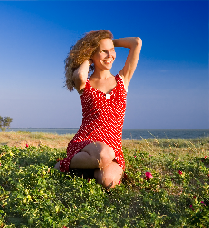



Helping you make healthy choices for you and your family

Stay Healthy in the Sun
When travelling abroad to a hotter climate where the sun is stronger than in the UK, it is very important to gradually increase your exposure to the sun. Fair skins burn much quicker than darker skins due to the amount of melanin present. This is a pigment in our skin cells that protects us and causes us to tan.
Ironically, we rely on the sun’s rays for Vitamin D, an essential nutrient to protect against cancer. When our skin is exposed to UVB rays, it kick starts a chain reaction that produces Vitamin D in fairly high amounts. Our diets today tend to be much lower in Vitamin D, so it is recommended that we make up the shortfall by exposing ourselves to the sun for 10 - 20 minutes every day. This would mean that covering the skin in sunblock may actually prevent us from manufacturing sufficient Vitamin D! Foods that contain Vitamin D are eggs and oily fish.
Another nutrient often lacking in our diet is an antioxidant called lycopene. Studies have shown that lycopene, found in tomatoes, aids in repairing damage from prolonged sun exposure. It also increases levels of melanin. By taking a tablespoon of tomato puree each day, studies have found that lycopene significantly reduces sunburn, and gives a SPF of 3.
Ironically, we rely on the sun’s rays for Vitamin D, an essential nutrient to protect against cancer. When our skin is exposed to UVB rays, it kick starts a chain reaction that produces Vitamin D in fairly high amounts. Our diets today tend to be much lower in Vitamin D, so it is recommended that we make up the shortfall by exposing ourselves to the sun for 10 -
Another nutrient often lacking in our diet is an antioxidant called lycopene. Studies have shown that lycopene, found in tomatoes, aids in repairing damage from prolonged sun exposure. It also increases levels of melanin. By taking a tablespoon of tomato puree each day, studies have found that lycopene significantly reduces sunburn, and gives a SPF of 3.
Whatever you do or wherever you go this summer, simply use some common sense and you should enjoy the benefits of the sun without harming your health.
Tips to stay safe in the sun
|
|
Expose your skin to the sun gradually in the weeks before your holiday so that the pigment cells, melanocytes, in your skin have time to increase and protect you.
|
|
|
Stay no longer than 20 minutes in the sun between 10am to 2pm when the rays are most harmful. This exposure will allow your body to produce Vitamin D from the UVB rays, which helps to protect against cancer.
|
|
|
If you cannot avoid the sun for longer than 20 minutes during those times, apply a good quality sunscreen that gives UVB and UVA protection with a minimum SPF of 15 (30+ for babies and children). Wear a hat and tight-
|
|
|
Be careful which sunscreen you use as some have chemicals which become toxic when exposed to heat (e.g. the sun!). Avoid ingredients such as oxybenzone and vitamin A (retinyl palmitate) which can cause skin lesions and tumours. Zinc, titanium dioxide and avobenzine are safer.
|
|
|
Take precautions, even in cloudy weather, as the sun can still burn through cloud.
|
|
|
Surfaces such as sand, snow, concrete, and water can reflect up to 85% of the UV radiation, so extra precautions should be taken when around them.
|
|
|
Eat foods high in lycopene, eg. cooked tomatoes, tomato puree, watermelon, pink grapefruit.
|
|
|
Keep your body well hydrated with water when out in the sun. Avoid fizzy/sugary drinks as they dehydrate.
|
Disclaimer: The information in this article should not be regarded as medical advice. If you are receiving medical treatment or taking prescribed medication, you are advised to consult your GP or health practitioner before making any changes to your diet or lifestyle.

When the summer arrives, most people have a natural instinct to get out into the sunshine. Yet, we are bombarded with warnings to keep out of the sun and protect our skin with sunscreen products, clothes and hats. However, we all need some sun exposure to stay healthy so here are some tips to keep your family safe as well as healthy in the sun.
Without the sun, life on this planet would cease to exist. Nevertheless, this powerful source of energy can be damaging if we expose ourselves to it for long periods. The ozone layer above the Earth, which is there to protect us, has depleted in recent years, resulting in a rise in skin cancer. Current figures from Cancer Research UK state that there are 8,100 new cases of the worst type, malignant melanoma, each year and 1,800 deaths.
The guidelines from health authorities around the world, advise us to limit our sun exposure, especially between 10am and 2pm. This is when the sun’s rays are most damaging. If you have to go out, a hat and clothing that covers your neck and shoulders should be worn. Also a sun cream or lotion with a minimum Sun Protection Factor (SPF) of 15 (30-40 for fair skins and children) should be applied to exposed areas to prevent sunburn. Malignant melanomas are most commonly found on the trunk in men and on the legs in women, places that often get forgotten when applying sun cream.
| Your Health Your Future |
| Controversial Ingredients |
| Nutritional State |
| Parent and Child |
| Microwave Ovens |
| Recommended Books |
| Skin Absorption |
| Sodium Lauryl Sulphate |
| Propylene Glycol |
| DEA, MEA, TEA |
| Chemical Calculator |
| Fluoride |
| Aspartame |
| Fluoridation |
| Water Filtration |
| Planning a Pregnancy |
| Pregnancy Care |
| Post Pregnancy Care |
| Amazon Books |
| EBooks |
| About Us |
| Health Services |
